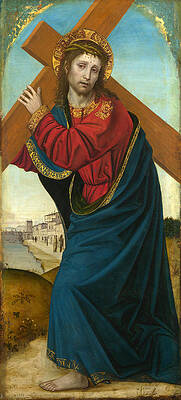Ambrogio Bergognone or Ambrogio Borgognone (variously known as Ambrogio da Fossano, Ambrogio di Stefano da Fossano, Ambrogio Stefani da Fossano or as il Bergognone)
Paintings



The Virgin and Child with Saints

Fine Art Prints | Greeting Cards | Phone Cases | Lifestyle | Face Masks | Men's , Women' Apparel | Home Decor | jigsaw puzzles | Notebooks | Tapestries | ...
Ambrogio Borgognone (variously known as Ambrogio da Fossano, Ambrogio di Stefano da Fossano, Ambrogio Stefani da Fossano or as il Bergognone, c. 1470s – 1523/1524) was an Italian Renaissance painter of the Milanese school.
Biography
While he was nearly contemporary with Leonardo da Vinci, he painted in a style more akin to the pre-Renaissance, Lombard art of Vincenzo Foppa and Bernardino Zenale. The dates of his birth and death are unknown; he is said to have been born at Fossano in Piedmont and his appellation attributed to his artistic affiliation with the Burgundian school.
His fame is principally associated with his work at the Certosa di Pavia complex, composed of the church and convent of the Carthusians. It is unlikely he designed, in 1473, the celebrated facade of the Certosa itself. He worked there for eight years starting in 1486, in collaboration with his brother Bernardino Bergognone, when he furnished the designs of the figures of the virgin, saints and apostles for the choir-stalls, executed in tarsia or inlaid wood work by Bartolomeo Pola, till 1494, when he returned to Milan. Only one known picture, an altar-piece at the Basilica of Sant'Eustorgio, can with probability be assigned to a period of his career earlier than 1486.
For two years after his return to Milan he worked at the church of San Satiro. From 1497 he was engaged for some time in decorating with paintings the church of the Incoronata in the neighboring Lodi. Documentation of him thenceforth is scant. In 1508 he painted for a church in Bergamo; in 1512, his signature appears in a public document of Milan; in 1524 - and this is our last authentic record - he painted a series of frescoes illustrating the life of St. Sisinius in the portico of San Simpliciano at Milan. Borgognone considered a modestly talented painter with marked individuality. He holds an interesting place in the most interesting period of Italian art.
The National Gallery, London, has a number or his works: the separate fragments of a silk banner painted for the Certosa, and containing the heads of two kneeling groups severally of men and women; and a large altar-piece of the marriage of St Catherine, painted for the chapel of Rebecchino near Pavia. There is also a painting of his at the Lowe Art Museum Madonna and Christ Child in Landscape.
But to judge of his real powers and peculiar ideals, his system of faint and clear coloring, whether in fresco, tempera or oil; his somewhat slender and pallid types, not without something that reminds us of northern art in their Teutonic sentimentality as well as their fidelity of portraiture; the conflict of his instinctive love of placidity and calm with a somewhat forced and borrowed energy in figures where energy is demanded, his conservatism in the matter of storied and minutely diversified backgrounds to judge of these qualities of the master as they are, it is necessary to study first the great series of his frescoes and altar-pieces at the Certosa, and next those remains of later frescoes and altarpieces at Milan and Lodi, in which we find the influence of Leonardo and of the new time mingling with, but not expelling, his first predilections.
Bernardino Luini is said to have been one of his pupils.
References
Public Domain This article incorporates text from a publication now in the public domain: Chisholm, Hugh, ed. (1911). Encyclopædia Britannica (11th ed.). Cambridge University Press.
----
Fine Art Prints | Greeting Cards | Phone Cases | Lifestyle | Face Masks | Men's , Women' Apparel | Home Decor | jigsaw puzzles | Notebooks | Tapestries | ...
----
Artist
A - B - C - D - E - F - G - H - I - J - K - L - M -
N - O - P - Q - R - S - T - U - V - W - X - Y - Z
Retrieved from "http://en.wikipedia.org/"
All text is available under the terms of the GNU Free Documentation License




